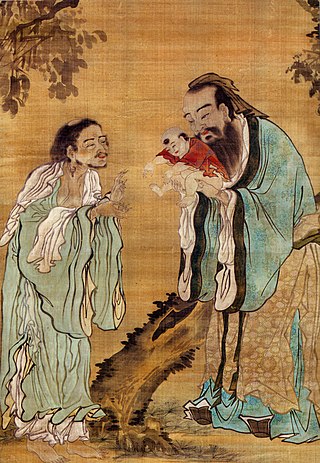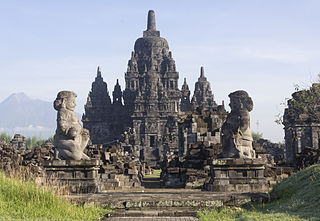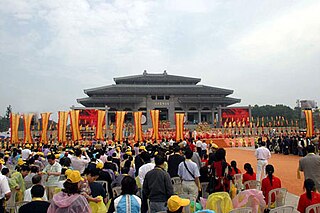
Religion in Japan is manifested primarily in Shinto and in Buddhism, the two main faiths, which Japanese people often practice simultaneously. According to estimates, as many as 80% of the populace follow Shinto rituals to some degree, worshiping ancestors and spirits at domestic altars and public shrines. An almost equally high number is reported as Buddhist. Syncretic combinations of both, known generally as shinbutsu-shūgō, are common; they represented Japan's dominant religion before the rise of State Shinto in the 19th century.

Comparative religion is the branch of the study of religions with the systematic comparison of the doctrines and practices, themes and impacts of the world's religions. In general the comparative study of religion yields a deeper understanding of the fundamental philosophical concerns of religion such as ethics, metaphysics and the nature and forms of salvation. It also considers and compares the origins and similarities shared between the various religions of the world. Studying such material facilitates a broadened and more sophisticated understanding of human beliefs and practices regarding the sacred, numinous, spiritual and divine.

Neo-Confucianism is a moral, ethical, and metaphysical Chinese philosophy influenced by Confucianism, which originated with Han Yu (768–824) and Li Ao (772–841) in the Tang dynasty, and became prominent during the Song and Ming dynasties under the formulations of Zhu Xi (1130–1200). After the Mongol conquest of China in the thirteenth century, Chinese scholars and officials restored and preserved neo-Confucianism as a way to safeguard the cultural heritage of China.

In Chinese philosophy, the three teachings are Confucianism, Taoism, and Chinese Buddhism. All of these three teachings are considered a harmonious aggregate. Literary references to the "three teachings" by prominent Chinese scholars date back to the 6th century. The term may also refer to a non-religious philosophy built on that aggregation.

A Buddhist temple or Buddhist monastery is the place of worship for Buddhists, the followers of Buddhism. They include the structures called vihara, chaitya, stupa, wat and pagoda in different regions and languages. Temples in Buddhism represent the pure land or pure environment of a Buddha. Traditional Buddhist temples are designed to inspire inner and outer peace.

Shinbutsu-shūgō, also called Shinbutsu shūShinbutsu-konkō, is the syncretism of Shinto and Buddhism that was Japan's main organized religion up until the Meiji period. Beginning in 1868, the new Meiji government approved a series of laws that separated Japanese native kami worship, on one side, from Buddhism which had assimilated it, on the other.

The Japanese term shinbutsu bunri (神仏分離) indicates the separation of Shinto from Buddhism, introduced after the Meiji Restoration which separated Shinto kami from buddhas, and also Buddhist temples from Shinto shrines, which were originally amalgamated. It is a yojijukugo phrase.

The Eastern religions are the religions which originated in East, South and Southeast Asia and thus have dissimilarities with Western, African and Iranian religions. This includes the East Asian religions such as Confucianism, Taoism, Chinese folk religion, Shinto, and Korean Shamanism; Indian religions such as Hinduism, Buddhism, Jainism, and Sikhism; and Southeast Asian religions such as Vietnamese folk religion as well as animistic indigenous religions.
Asia is the largest and most populous continent and the birthplace of many religions including Buddhism, Christianity, Confucianism, Hinduism, Islam, Jainism, Judaism, Shinto, Sikhism, Taoism and Zoroastrianism. All major religious traditions are practiced in the region and new forms are constantly emerging. Asia is noted for its diversity of culture.

Taoism or "Do" is thought to be the earliest state philosophy for the Korean people. However, its influence waned with the introduction of Buddhism during the Goryeo kingdom as the national religion and the dominance of neo-Confucianism during the Joseon dynasty. Despite its diminished influence during those periods, it permeated all strata of the Korean populace, integrating with its native animism as well as Buddhist and Confucian institutions, temples, and ceremonies. The Taoist practice in Korea developed, somewhat in contrast to China, as an esoteric meditative practice in the mountains taught by the "mountain masters" or "mountain sages".

Religion in Taiwan is characterised by a diversity of religious beliefs and practices, predominantly those pertaining to the continued preservation of the ancient Chinese culture and religion. Freedom of religion is inscribed in the constitution of the Republic of China (Taiwan). The majority of Taiwanese people practice a combination of Buddhism and Taoism often with a Confucian worldview, which is collectively termed as Chinese folk religion.

In the study of comparative religion, the East Asian religions or Taoic religions, form a subset of the Eastern religions. This group includes Chinese religion overall, which further includes Ancestral Worship, Chinese folk religion, Confucianism, Taoism and popular salvationist organisations, as well as elements drawn from Mahayana Buddhism that form the core of Chinese and East Asian Buddhism at large. The group also includes Japanese Shinto, Tenrikyo, and Korean Muism, all of which combine Shamanistic elements and indigenous ancestral worship with various influences from Chinese religions. Chinese salvationist religions have influenced the rise of Japanese new religions such Tenriism and Korean Jeungsanism; as these new religious movements draw upon indigenous traditions but are heavily influenced by Chinese philosophy and theology.
The term honji suijaku or honchi suijaku (本地垂迹) in Japanese religious terminology refers to a theory widely accepted until the Meiji period according to which Indian Buddhist deities choose to appear in Japan as native kami to more easily convert and save the Japanese. The theory states that some kami are local manifestations of Buddhist deities. The two entities form an indivisible whole called gongen and in theory should have equal standing, but this was not always the case. In the early Nara period, for example, the honji was considered more important and only later did the two come to be regarded as equals. During the late Kamakura period it was proposed that the kami were the original deities and the buddhas their manifestations.

The term shinbutsu kakuri in Japanese Buddhist terminogy refers to the tendency in medieval and early modern Japan to keep some kami separate from Buddhism. While some kami were integrated in Buddhism, others were kept systematically away from Buddhism. This phenomenon had significant consequences for Japanese culture as a whole. It should not be confused with shinbutsu bunri or with haibutsu kishaku, which are phenomenons recurrent in Japanese history and usually due to political causes. While the first assumes the acceptance of Buddhism, the second and third actually oppose it.

Myōken, also known as Sonjō-Ō, is a Buddhist deification of the North Star worshiped mainly in the Shingon, Tendai and Nichiren schools of Japanese Buddhism.

In Japan, a chinjusha is a Shinto shrine which enshrines a tutelary kami; that is, a patron spirit that protects a given area, village, building or a Buddhist temple. The Imperial Palace has its own tutelary shrine dedicated to the 21 guardian gods of Ise Shrine. Tutelary shrines are usually very small, but there is a range in size, and the great Hiyoshi Taisha for example is Enryaku-ji's tutelary shrine. The tutelary shrine of a temple or the complex the two together form are sometimes called a temple-shrine. If a tutelary shrine is called chinju-dō, it is the tutelary shrine of a Buddhist temple. Even in that case, however, the shrine retains its distinctive architecture.

Until the Meiji period (1868–1912), the jingū-ji were places of worship composed of a Buddhist temple and a Shintō shrine, both dedicated to a local kami. These complexes were born when a temple was erected next to a shrine to help its kami with its karmic problems. At the time, kami were thought to be also subjected to karma, and therefore in need of a salvation only Buddhism could provide. Having first appeared during the Nara period (710–794), jingū-ji remained common for over a millennium until, with few exceptions, they were destroyed in compliance with the Kami and Buddhas Separation Act of 1868. Seiganto-ji is a Tendai temple part of the Kumano Sanzan Shinto shrine complex, and as such can be considered one of the few shrine-temples still extant.

Mountain Gods (山神) are Asian tutelary deities associated with mountains. They are related to landlord deities and tudigongs and City Gods.

Mountain worship is a faith that regards mountains as sacred objects of worship.

















